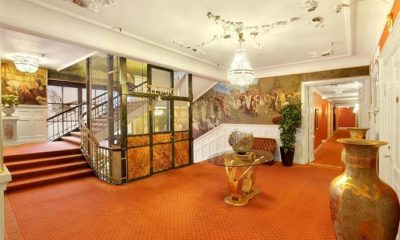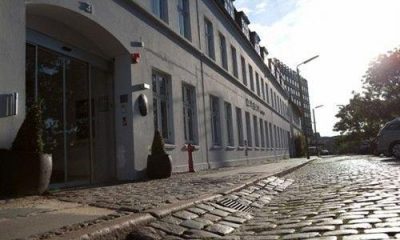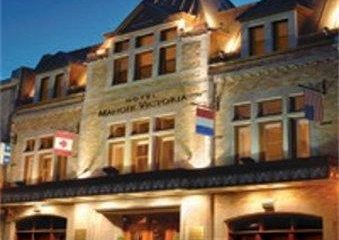Visit to Rome
25 Ultimate Things to Do in Rome
- /home/discountdealsonh/public_html/wp-content/plugins/mvp-social-buttons/mvp-social-buttons.php on line 27
https://www.discountdealsonhotels.com/wp-content/uploads/2017/08/2-the-colosseum.jpg&description=25 Ultimate Things to Do in Rome', 'pinterestShare', 'width=750,height=350'); return false;" title="Pin This Post">
- Share
- Tweet /home/discountdealsonh/public_html/wp-content/plugins/mvp-social-buttons/mvp-social-buttons.php on line 69
https://www.discountdealsonhotels.com/wp-content/uploads/2017/08/2-the-colosseum.jpg&description=25 Ultimate Things to Do in Rome', 'pinterestShare', 'width=750,height=350'); return false;" title="Pin This Post">

It may be a cliché, but there’s no better advice for visitors to the Eternal City than the old adage, “When in Rome, do as the Romans do.” This is where la dolce vita originated, after all. Of course, after more than 2,000 years in existence, there’s enough to explore to keep you busy for years, with decadent pasta and gelato to indulge in, places to shop for everything from handicrafts to haute couture, archeological sites, Baroque churches, villas-turned-museums, and enough art to overload your senses. Whether you’ve never visited Rome or return often, here are twenty-five things you absolutely must do.
By Laura Itzkowitz

Admire Ancient Ruins at the Roman Forum
Entering the huge archeological site of the Roman Forum and strolling through the ruins, you can almost imagine the citizens of Ancient Rome walking the cobblestoned streets in togas and bringing sacrifices to the temples. Of course, it helps to have a guide who can bring the stories to life, or you might mistake Augustus’s house for Livia’s, as there are no signs within the complex indicating what’s what.
The site dates back to around 500 B.C., but was enlarged by Julius Caesar, Augustus Caesar, Domitian, and Trajan. In fact, you’ll see remnants of Imperial Rome extending beyond the limits of the Forum to include Trajan’s Column, the Arch of Titus, and the Circus Maximus, just to name a few.
After visiting the Forum, try your luck with the Bocca della Verità, an ancient stone carving of a bearded man’s face. According to myth, it will bite off the hand of anyone not telling the truth.
PLAN YOUR TRIP: Visit Fodor’s Rome Travel Guide

Visit the Colosseum
The most internationally recognized symbol of Rome, the Colosseum has a long and bloody history. It was inaugurated in 80 A.D. with 100 days of games, including gladiatorial combats and animal fights. It was the largest amphitheater in the Roman Empire and is believed to have packed up to 50,000 people inside. Despite centuries of neglect—it was used as a quarry until the eighteenth century—it has remained intact (for the most part).
Today nearly 4 million people visit annually. Buy your tickets in advance or be prepared to wait in a very long line. A combined ticket for the Roman Forum, Colosseum, and Palatine Hill grants access to all three sites and lets you skip the line at the Colosseum.
PLAN YOUR TRIP: Visit Fodor’s Rome Travel Guide

Gaze at the Architectural Marvel That is the Pantheon
Though the name refers to a temple for all the gods, the Pantheon is actually the burial place of Rome’s kings and other prominent figures, including Raphael. The temple was built between 118 and 128 A.D. on the site of an older temple. A feat of architectural ingenuity, it was the world’s largest dome until the modern era, has been called the world’s only architecturally perfect building, and is the best-preserved monument of Imperial Rome. Walk inside and look up—the oculus in the dome is open to the sky, letting sunlight filter in.
PLAN YOUR TRIP: Visit Fodor’s Rome Travel Guide
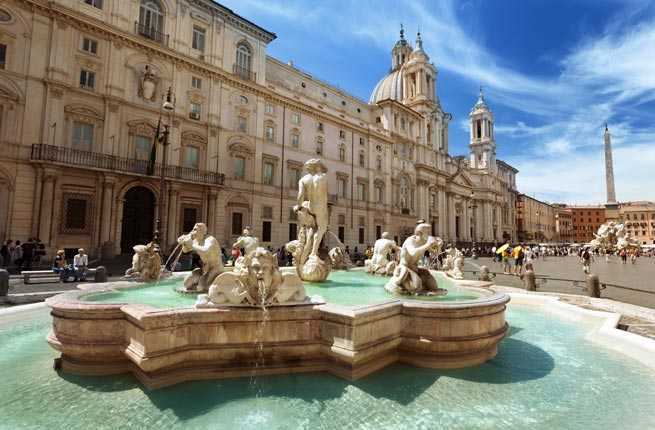
Transport Yourself to Baroque Rome at Piazza Navona
One of the most popular public spaces in Rome, the magnificent, oval-shaped Piazza Navona is lined with restaurants, gelaterias, souvenir shops, and the Museo di Roma inside the Renaissance Palazzo Braschi. The city’s Baroque art is on full display here. Bernini’s Fontana dei Quattro Fiumi features exquisitely carved figures representing the world’s four great rivers, and legend has it that the figure with his arms extended is recoiling in horror from the church of Sant’Agnese in Agone by Borromini, Bernini’s rival.
Wander down the small street next to the church and make your way toward Via della Pace, one of the city’s most picturesque streets. At the end stands the church of Santa Maria della Pace, its white portico gleaming in the sun. Make time to stop for un caffè or a glass of wine at Antico Caffè della Pace, a legendary nineteenth-century haunt still as chic as ever and one of the best places for a classic Italian aperitivo.
PLAN YOUR TRIP: Visit Fodor’s Rome Travel Guide

Pay Your Respects to the Vatican and Its Museums
You could easily spend a whole day exploring the area around the Vatican. Start at the Piazza di San Pietro, which Bernini designed to look like arms extended in an embrace. Besides St. Peter’s Basilica, the absolute must-see is the Vatican Museums, which contain Michelangelo’s Sistine Chapel. Other highlights in the 1,400-room palace include the Raphael Rooms, old master paintings, and antique sculptures.
Just south of Vatican City stands Castel Sant’Angelo, where popes sought solace during sieges. Climb to the top for splendid views of Vatican City and the Tiber. At its base you can see the Ponte Sant’Angelo with Bernini’s exquisitely carved marble angels.
PLAN YOUR TRIP: Visit Fodor’s Rome Travel Guide

Visit St. Peter’s Basilica
St. Peter’s Basilica may be a pilgrimage site for Catholics, but even non-believers can appreciate the church’s architectural majesty. The original dates back to 349 A.D., when Constantine had a basilica built over the tomb of St. Peter, the first pope. That church was razed to make way for the current one, the world’s largest church at 18,000 square yards, which has been standing on this spot since 1626. Inside you’ll find Bernini’s masterful altarpiece—the great bronze baldacchino—and Michelangelo’s Pietà.
PLAN YOUR TRIP: Visit Fodor’s Rome Travel Guide

Climb the Spanish Steps
Fascinating in its contradictions, the Piazza di Spagna is both democratic and home to the city’s fanciest boutiques on Via dei Condotti, Rome’s legendary shopping street. Climb the famous steps leading to the Trinità dei Monti church to admire the piazza and Bernini’s ship-shaped fountain from above. If you’re feeling ambitious, climb to the Villa Medici for stunning views of the Centro Storico. Off to the side of the steps, you’ll find the Keats-Shelley Memorial House, one of Rome’s excellent under-the-radar museums.
PLAN YOUR TRIP: Visit Fodor’s Rome Travel Guide

Explore Trastevere
Trastevere means “across the Tiber,” and once you cross the river, you’ll notice the difference. The vibe is hip and bohemian, and you’ll find plenty of boutiques selling jewelry, perfumes, and handicrafts in a neighborhood where you can stroll aimlessly through the cobblestoned streets flanked by ochre buildings and stumble upon amazing discoveries.
At night, Trastevere buzzes with people hanging out and drinking at the bars that line the streets. It’s easy to wander around and find one that appeals to you, but a good place to start is Freni e Frizioni, which serves a great aperitivo and cocktails with fresh fruit.
PLAN YOUR TRIP: Visit Fodor’s Rome Travel Guide

Throw a Coin in the Trevi Fountain
Any trip to Rome would be incomplete without a visit to the Trevi Fountain. Nicola Salvi’s awe-inspiring Baroque masterpiece features a marble statue of Neptune at the center, surrounded by tritons. Legend has it that anyone who throws a coin in the fountain will return to Rome.
Unfortunately, the gorgeous fountain tends to be overrun by tourists vying for that perfect selfie angle and street hawkers selling cheap souvenirs. Visit early in the morning or late at night, when the crowds disperse. You might just experience a magical moment like in La Dolce Vita when Marcello Mastroianni wades into the fountain after Anita Ekberg.
PLAN YOUR TRIP: Visit Fodor’s Rome Travel Guide

Admire Masterpieces in Galleria Borghese and Stroll Through Villa Borghese
Nowhere in Rome—or dare we say, the world—will you find such a magnificent collection of Baroque art. The villa itself is a masterpiece, commissioned by seventeenth-century Cardinal Scipione Borghese to house his treasures, including Antonio Canova’s sculpture of Napoleon Bonaparte’s sister as Venus Victrix, Bernini’s Apollo and Daphne, and Caravaggio’s self portrait as Bacchus. Tickets must be reserved in advance for slotted times.
After perusing the villa’s galleries, take a leisurely stroll through the idyllic Villa Borghese park, where orange trees and flowers bloom. Meander south toward Piazza del Popolo. You can take rowboat out on the lake, visit the zoo, see a play at a replica of Shakespeare’s Globe Theater, or stop by two museums on the park’s edge: the Etruscan Museum in Villa Giulia and the Galleria Nazionale d’Arte Moderna.
PLAN YOUR TRIP: Visit Fodor’s Rome Travel Guide

Get Lost in the Centro Storico
One of Rome’s great joys is losing yourself in the narrow cobblestone streets that make up Centro Storico. Starting at Piazza del Popolo, three main roads form a trident leading toward Piazza Venezia and the Colosseum. Branching off are countless streets and alleyways where you’ll find churches with Baroque art, boutiques selling everything from carved wooden figurines to precious jewelry, private courtyards where the wealthiest Romans live, enticing gelaterias, cafés, and restaurants. Take your time and do as the Romans do—this is what la dolce vita is all about.
PLAN YOUR TRIP: Visit Fodor’s Rome Travel Guide

Shop Until You Drop at the Galleria Alberto Sordi
Take a mid-afternoon break and have coffee at the Illy kiosk at the Galleria Alberto Sordi. The galleria, which dates to 1922 and features stained-glass skylights and mosaic floors, is one of Europe’s most gorgeous places to shop. Check out stores like La Rinascente (Italy’s Macy’s), Zara, Massimo Dutti, and the Italian mega bookstore La Feltrinelli. For designer boutiques, walk along Via Condotti and the surrounding streets. For vintage and Italian heritage brands, stroll through the Campo Marzio.
PLAN YOUR TRIP: Visit Fodor’s Rome Travel Guide

Drink Espresso
When in Rome, you must drink espresso. Drip coffee and Starbucks don’t exist here. It’s not uncommon for Romans to drink three or more espressos a day, and there are some unspoken rules if you don’t want to look like a tourist when ordering. First, cappuccinos are only drunk at breakfast. After that, order un caffè (a shot of espresso) or un caffè macchiato (a shot of espresso with a dollop of steamed milk). If you ask for a latte, you’ll simply get milk. In the hotter months, ask for un caffè freddo (cold espresso sweetened with loads of sugar) or crema di caffè (the Roman equivalent of a frappuccino).
Two of the most famous cafés—Tazza d’Oro and Caffè Sant’Eustachio—hold a fierce rivalry and are just blocks from each other. Try them both and see which you prefer.
PLAN YOUR TRIP: Visit Fodor’s Rome Travel Guide

Take an Early Evening Break for Aperitivo
After work, Romans love to meet for aperitivo, the Italian happy hour. Any bar worth its salt offers snacks, though these range from peanuts and potato chips to elaborate buffets of the finest finger food you’ve ever eaten. ‘Gusto, a modern, airy restaurant and bar, goes all out with a selection of cheese, arancini, mini pizzas, salads, and other delicacies, all included in the price of a drink. An Aperol Spritz is the classic Roman aperitivo, but Fragolino—a sweet sparkling wine that tastes like strawberries—comes in at a close second. Read more about Rome’s ten best bars for a classic aperitivo here.
PLAN YOUR TRIP: Visit Fodor’s Rome Travel Guide

Shop at the Market at Campo de’ Fiori
Shopping for fresh fruit and vegetables at the mercato is a way of life for many Romans. Lots of neighborhoods have their own markets, and the produce tends to be very high quality—perfect for preparing salads and sandwiches for a picnic. Even if you’re just visiting, you can immerse yourself in the local culture by shopping at the market. The one at Campo de’ Fiori bustles with vendors every morning except Sunday and is one of the city’s most popular.
PLAN YOUR TRIP: Visit Fodor’s Rome Travel Guide

Eat Gelato at Giolitti
Rome has no shortage of excellent gelaterias, and many Romans are steadfastly loyal to their favorite. Giolitti, a few blocks from the Pantheon, is the city’s best old-school gelateria. It’s been around since 1900 and serves dozens of flavors in a rainbow of hues. If you’re getting yours to go—and it’s less expensive if you do—line up at the cashier and pay before ordering. A small cone gets you two flavors plus whipped cream.
PLAN YOUR TRIP: Visit Fodor’s Rome Travel Guide

See Modern Art at MAXXI
With so much amazing ancient and Baroque art, it’s easy to forget that Rome has some wonderful modern art museums too. MACRO is great, but MAXXI (Museum of 21st Century Art) is arguably the best place to see modern and contemporary art. The building itself is a huge draw—designed by Zaha Hadid, it’s all glass, big open spaces, and staircases that seem to float in the air. Currently on view is a retrospective of Olivo Barbieri, one of Italy’s most important contemporary photographers.
PLAN YOUR TRIP: Visit Fodor’s Rome Travel Guide

Ascend Gianicolo for Panoramic Views
Rome was built on seven hills, and while Gianicolo (or Janiculum) isn’t technically one of them, it is the highest vantage point from which to see the city. Roman lovers gather here at dusk (it’s an infamous makeout spot), and street vendors may try to sell you glowing tchotchkes. But ignore all that and focus on the panoramic vistas. From up here, you can see all the most important monuments: the Spanish Steps, Palazzo Venezia, and beyond. The long and winding road can be quite a hike to the top, so it’s better to go by car or Vespa if you can.
PLAN YOUR TRIP: Visit Fodor’s Rome Travel Guide

Sample Fried Artichokes in the Jewish Ghetto
The Jewish Ghetto, full of distinct charms, forms a small area between Campo de’ Fiori and Piazza Venezia. From the Renaissance until the nineteenth century, its gates were locked after sunset. Today it still feels distinct from other neighborhoods because of its concentration of Jewish restaurants, shops, and bakeries. Ristorante Piperno is one of the oldest and best places to get carciofi alla giudia (Jewish artichokes), which are fried whole and absolutely delicious. Also try the fiori di zucca (fried stuffed zucchini flowers).
PLAN YOUR TRIP: Visit Fodor’s Rome Travel Guide

Indulge in La Cucina Romana
Italian cuisine is very regional, and though you might see dishes like ragù alla bolognese (the typical meat sauce that hails from Bologna) on restaurant menus, stick to Roman dishes. Traditionally dubbed la cucina povera, Roman specialties tend to be simple, with a few ingredients prepared using tried-and-true methods.
Typical appetizers include fried artichokes, fried salt cod filets, and plenty of cheese and salumi. The most classic Roman pastas are bucatini all’amatriciana, a spicy tomato sauce with peperoncino, guanciale (pig’s cheek), and pecorino romano; spaghetti alla carbonara, a creamy sauce made with raw egg yolk, black pepper, guanciale, and pecorino romano; and tagliatelle cacio e pepe, a winning combination of pecorino romano and black pepper.
To try these dishes in a typical no frills Roman trattoria, head to La Carbonara in Monti. For fine dining with avant-garde takes on Rome’s traditional dishes, go to the Michelin-starred Ristorante All’Oro.
PLAN YOUR TRIP: Visit Fodor’s Rome Travel Guide

Find the Secret Keyhole in the Aventino
If you want to impress your fellow travelers, find the nondescript door to the Priory of the Knights of Malta up on the Aventine Hill, just past the orange grove. Peep through the keyhole and you’ll spy a perfect view of Saint Peter’s Basilica across the city. No one knows if it was designed that way or if it was just a lucky coincidence, but the centuries-old building is truly majestic. Before entering the hands of the Knights of Malta, it was a fortified palace belonging to Alberico II, who ruled Rome from 932-954, a Benedictine monastery, and home to the Knights of Templar.
PLAN YOUR TRIP: Visit Fodor’s Rome Travel Guide

Find Caravaggio’s Greatest Paintings in Churches
Stumble into just about any church and you’re likely to see some impressive art and architecture. There are a few, however, with altars by Caravaggio and other Renaissance and Baroque masters that will leave you awestruck.
On Piazza del Popolo, the church of Santa Maria del Popolo holds two of Caravaggio’s masterpieces: the Crucifixion of Saint Peter and the Conversion of Saint Paul. Raphael, Bernini, and Pinturicchio also contributed to its splendid interiors. Near Piazza Navona, the smaller, unassuming church of San Luigi dei Francesi displays three of Caravaggio’s greatest works: the Calling of St. Matthew, Matthew and the Angel, and Matthew’s Martyrdom.
PLAN YOUR TRIP: Visit Fodor’s Rome Travel Guide

Visit Cinecittà
For movie lovers, a visit to Cinecittà Studios provides a chance to bask in the glory of cinematic greatness. Some of the great classics were filmed here, including Fellini’s La Dolce Vita (most of Fellini’s films, in fact), Roman Holiday (you can also see where Gregory Peck lived on Via Margutta), and Cleopatra starring Elizabeth Taylor. More recently, Martin Scorsese filmed Gangs of New York there. Guided tours are available, and you can see the exhibition Cinecittà Shows Off.
PLAN YOUR TRIP: Visit Fodor’s Rome Travel Guide

Experience the Nightlife in Testaccio
As shown in films like La Dolce Vita and the more recent La Grande Bellezza, Romans know how to party. After dark, the city becomes a playground for bacchanalia. In Fellini’s day, Via Veneto was the place to go, but nowadays the epicenter of nightlife is farther south in Testaccio. Formerly a working class neighborhood and home to the city’s largest butchery, Testaccio is now filled from end to end with a profusion of bars and nightclubs, and the party doesn’t stop until dawn. A word to the wise: Be careful in your choice of footwear. The cobblestone streets are a dire enemy of stilettos.
PLAN YOUR TRIP: Visit Fodor’s Rome Travel Guide

Take a Day Trip to the Sea
It seems like all the locals have a house by the sea, and when the sweltering heat of summer sets in, it’s easy to understand why. Rome isn’t directly on the Mediterranean, but you don’t have to go far to find great beaches. If you have an extra day to escape the city, a trip out to one of the seaside towns surrounding Rome is absolutely worth it.
Popular spots among the locals include Ostia Antica (you’ll pass by Roman aqueducts on the train ride there), Fregene, and Cerveteri. Farther south, about halfway to Naples, there’s the whitewashed, unblemished town of Sperlonga—the perfect place for some R&R after all that partying in Testaccio.
PLAN YOUR TRIP: Visit Fodor’s Rome Travel Guide
Visit to Rome
Rome’s 10 Best Bars for a Classic Italian Aperitivo
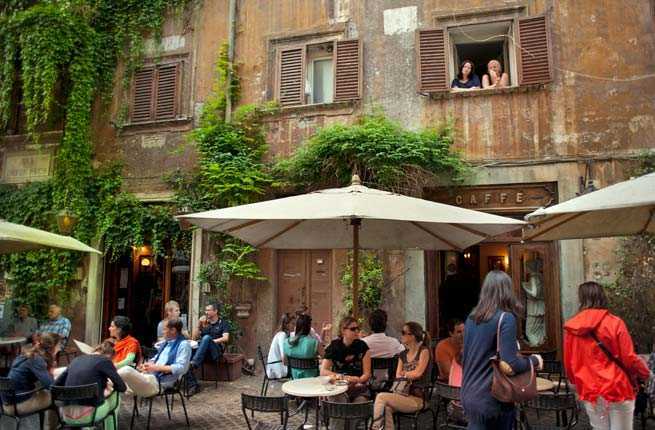
Italians and visitors alike love happy hour, known in Italy as l’aperitivo. After work, friends and colleagues often meet for a drink and a tapas-style snack before dinner. In Rome, the tradition is especially strong, and many cafés and bars include snacks in the price of a drink. The classic Roman aperitivo is a spritz, made of white wine or Prosecco, Campari or Aperol (bartenders often ask which you prefer), and sparkling water. If that’s not your drink of choice, many bars serve a full cocktail menu, and you can find a glass of wine everywhere. Whatever you prefer, you’ll find it at one of these 10 Roman bars, which all serve an excellent aperitivo.
by Laura Itzkowitz
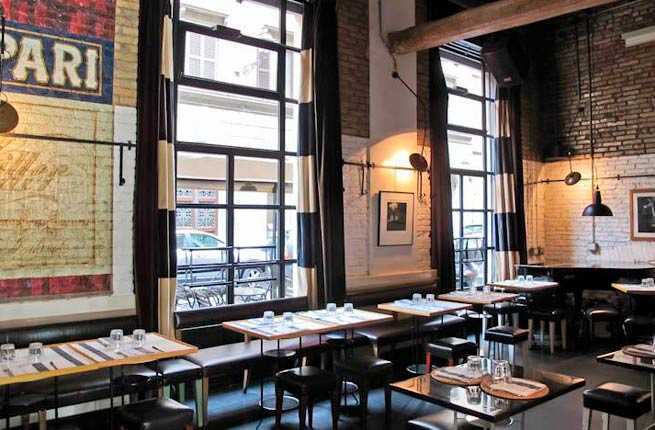
‘GUSTO
Hands down, ‘Gusto serves the best aperitivo buffet in Rome. Every evening of the week, the wine bar sets out a full spread of small bites, including Sicilian-style arancini, mini-sandwiches, salads, little squares of pizza, and pizzette—savory phyllo dough pastries with a dab of tomato sauce. For 10€, chose one of the excellent cocktails and head to the unlimited buffet. ‘Gusto has an extensive wine list as well, and the friendly bartenders will be happy to help you make a selection.
Insider Tip: If ‘Gusto’s wine bar is too crowded, head next door to the Formaggeria, which has a great selection of cheeses and small bites. ‘Gusto also serves an excellent buffet brunch on the weekends.

ANTICO CAFFE DELLA PACE
The Caffè della Pace is about as close as you can get to living in La Dolce Vita. Tucked away behind Piazza Navona, this popular spot is favored by Robert De Niro, Al Pacino, and Francis Ford Coppola, who gather there when they’re in Rome. It’s been around since the 1880s, and the mahogany interior, marble tables, sculpted nymphs, and antique cash register certainly enhance its Old World charm. In the warmer months, the terrace is packed, so don’t be surprised if there’s a wait. But it’s worth it for the drinks, the atmosphere, and the people-watching.
Insider Tip: If you’re in the mood for something sweet, order the Fragolino, a sparking Italian wine that tastes like strawberries.

FRENI E FRIZIONI
Trastevere, Rome’s hip, artsy neighborhood, is always buzzing, and Freni e Frizioni is no exception. In the warmer months, crowds spill out onto the terrace overlooking the Tiber and Piazza Trilussa. The bartenders here are expert mixologists—tell them what flavors you like and they’ll create a cocktail for you using fresh fruit and a combination of liquors. They also set up a great aperitivo buffet in the back, if you can navigate the people milling about.
Insider Tip: If you’re still hungry after aperitivo, there are plenty of great restaurants nearby, like Trattoria degli Amici, which serves traditional Roman cuisine and is dedicated to helping the mentally disabled.
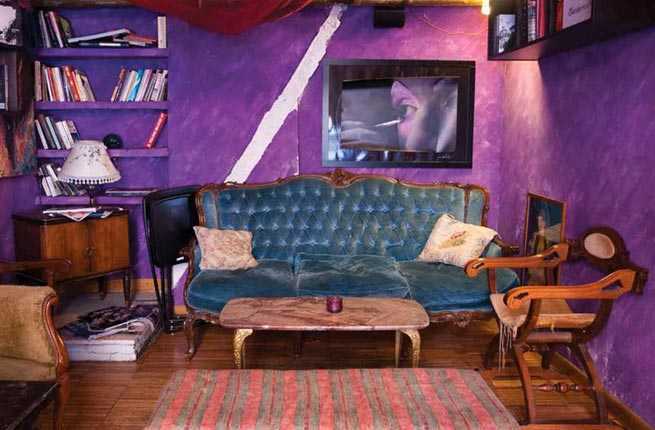
LIBRERIA CAFFE BOHEMIEN
Perched on one of Monti’s quieter streets is the cozy Caffè Bohemien, sometimes known as Libreria. This little place is full of vintage furniture and books, and is a mainstay in the charming bohemian neighborhood near the Coliseum. The friendly owners will be happy to serve you some snacks along with your wine. The vibe here is relaxed and welcoming. Every now and then, they host book readings.
Insider Tip: The bar is closed on Wednesdays, but there are plenty of other great spots in Monti.
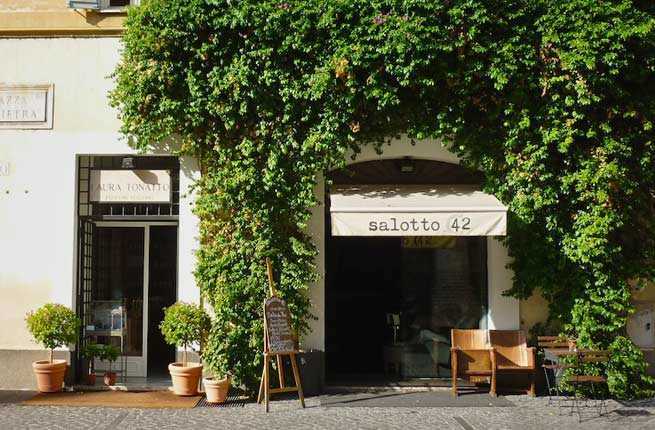
SALOTTO 42
Located on the Piazza di Pietra just steps away from the Pantheon, Salotto 42 is a modern, Swedish-inspired bar and lounge. The décor is carefully curated, down to the art magazines scattered around for guests to browse. Salotto means “living room” in Italian, and this spot is intended to make people feel at home. Grab a cocktail, fill up a plate with snacks, and find yourself a seat on one of the little sofas. If you stay long enough, the music will pick up as the vibe becomes more energized.
Insider Tip: If you want to fit in here, you might want to dress up: This trendy spot is owned by a Swedish model.

FLUID
If you peer in the windows of Fluid when passing by, you might think people are sitting on giant blocks of ice, but that’s just part of the décor, which tends toward the ultra-modern. Fluid’s sleek interior goes well with its great cocktail selection and aperitivo buffet. It’s one of the few places in Rome that serves Brazilian food, like fried plantains.
Insider Tip: When the DJ starts spinning tunes, people like to party here.

L’ENOTECA ANTICA DI VIA DELLA CROCE
One of the best wine bars in Rome, L’Enoteca Antica purveys a superb wine selection and the bartenders will be happy to give you a recommendation. Locals and foreigners mingle at the half-moon bar and the atmosphere is very inviting. Bartenders will carve you a hunk of cheese right off a giant wheel of Parmeggiano, along with prosciutto and marinated artichokes, olives, and other veggies. The enoteca has tables with waiter service and a full menu in the back, but the best people-watching is at the bar or at one of the tables on the street.
Insider Tip: Try a glass of the Brunello di Montalcino—it’s the best.
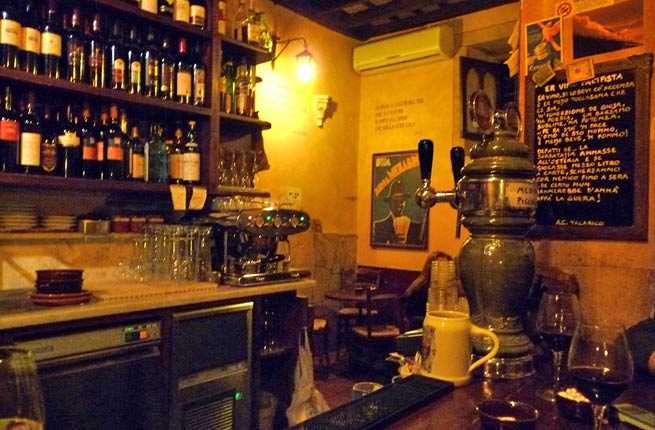
AI TRE SCALINI
This rustic wine bar is perched on Via Panisperna, a steeply sloping cobblestone street in Monti, where ivy and twinkling lights mingle, creating a very romantic atmosphere. In the evening, friends and lovers flock to Ai Tre Scalini to share a liter of the house wine and antipasti. Inside, quotes by Dante and other Italian writers are painted on the yellow walls. This place fills up after dinner, with people spilling out onto the street, drinking and talking the night away.
Insider Tip: Check the chalkboard to see which wines are available. When in doubt, order the house wine.
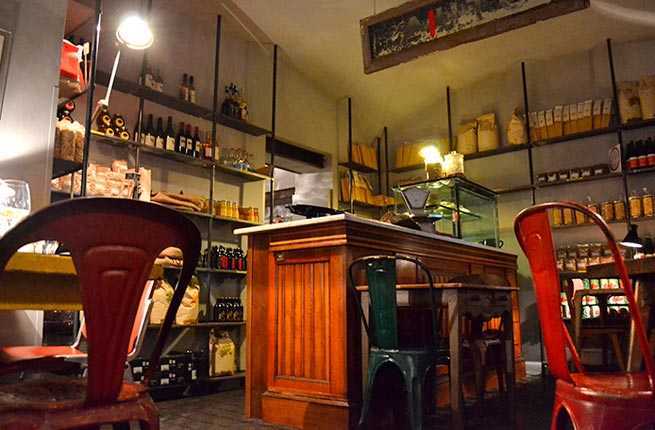
URBANA 47
Urbana 47 on Via Urbana looks like a restaurant you might stumble upon in Brooklyn. It’s an eclectic spot, with modern décor in an ancient space. The menu is eclectic too, with both Roman specialties and more exotic dishes (for Rome, anyway) like vegetable tempura, couscous with vegetables and curry sauce, and beef kabobs with BBQ sauce.
Insider Tip: Urbana 47 is great for foodies, and they have a tasty lunch and dinner menu, too. It’s also one of the few places in Rome where you can get a full American breakfast.
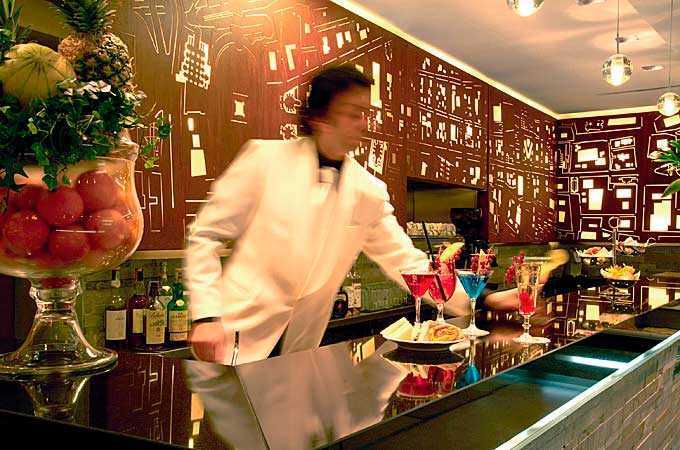
BAR CANOVA
Along with Rosati, Bar Canova is one of two famous bars on Piazza del Popolo. Though both are well respected and are perfectly positioned for people-watching, Canova is the more down-to-earth of the two. It was Federico Fellini’s favorite bar—in fact, he kept an office in the back, for when he wanted to meet people privately. To this day, Canova displays his drawings and photographs with the stars of his movies in the hall. In addition to aperitivo, Canova serves coffee any time of day, plus sandwiches and pastries. The best part: Despite the location, Canova is very reasonably priced.
Insider Tip: If you’re coming to see the Fellini memorabilia, head around the corner afterward to see his apartment on Via Margutta.
Visit to Rome
10 Under-the-Radar Museums in Rome
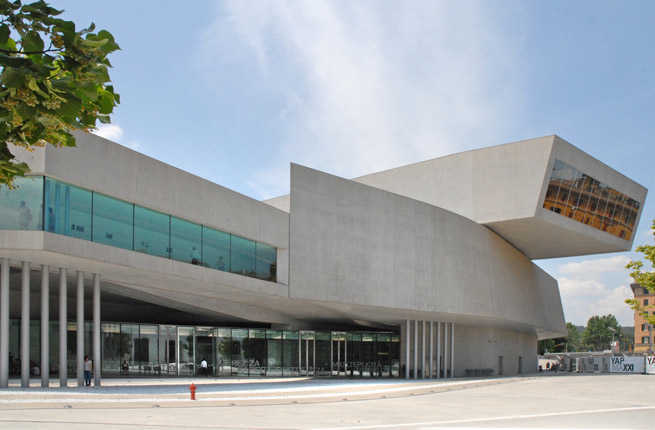
Attribution-NonCommercial-ShareAlike License
Rome has such an overwhelming amount of ancient and baroque art that it can be easy to forget about the city’s wide variety of museums. Of course, no trip to the Eternal City would be complete without a visit to the Vatican Museums and the Capitoline Museums, but besides those, Rome has plenty of excellent cultural institutions that often go overlooked. From the world’s most impressive collection of Etruscan art to contemporary works housed in one of architect Zaha Hadid’s modern masterpieces, here are 10 lesser-known museums that contain some surprising finds in Rome.
by Laura Itzkowitz
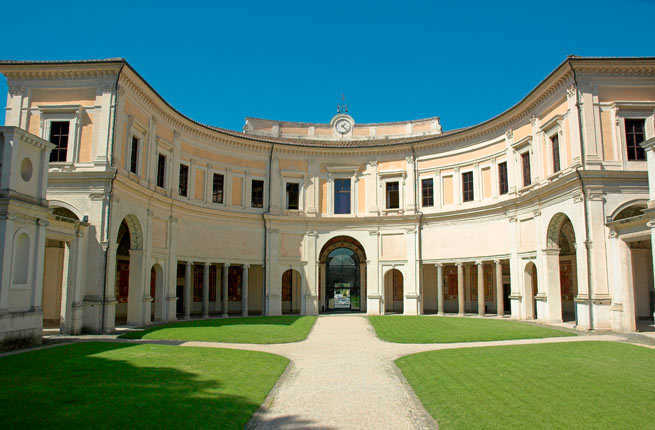
MUSEO NAZIONALE ETRUSCO DI VILLA GIULIA
Villa Borghese
Little attention is paid to Etruscan art in Rome, except at the Museo Nazionale Etrusco di Villa Giulia (the National Etruscan Museum of Villa Julia), where it takes center stage. The Etruscans were an ancient civilization that settled in Tuscany, Umbria and the area surrounding Rome, and they had a great influence on ancient Roman culture. The museum is worth a visit for its collection—the world’s best collection of Etruscan art and artifacts—and its architecture (though that came much later). Villa Giulia was built around 1551 for Pope Julius III, with help from Michelangelo and Vasari.
Insider Tip: If the weather is nice, go for a stroll in the lovely Villa Borghese park near the museum. To see ancient Etruscan ruins, you’ll have to take a day trip to Tarquinia or Cerveteri.
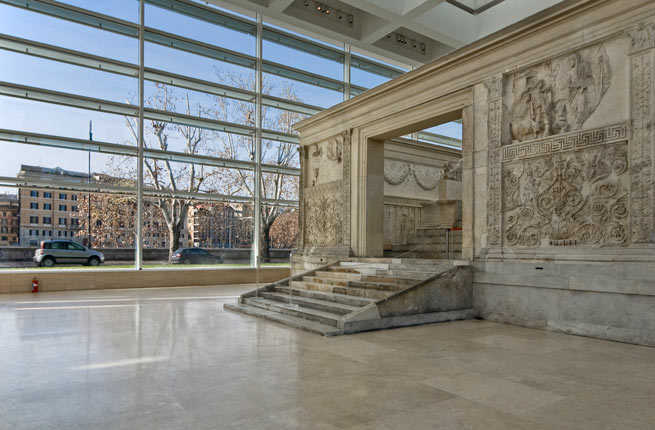
ARA PACIS AUGUSTAE
Corso and Spagna
Augustus’s altar of peace is a marvel to behold, decorated with delicate carvings and friezes depicting the imperial family and myths associated with Rome’s founding. The Roman Senate commissioned it in 13 B.C. to celebrate the Pax Romana, an era of peace brought on by the Emperor Augustus’s successful military campaigns. The ancient altar—lost for over a 1,000 years and rediscovered, piece by piece—is now housed inside Richard Meier’s modern architectural masterpiece, built using Roman travertine and glass. The result is a striking juxtaposition of ancient and modern. In addition to housing the altar, the museum hosts temporary exhibits downstairs.
Insider Tip: After a visit to the Ara Pacis, head over to ‘Gusto, one of the best bars in Rome for a classic Italian aperitivo.
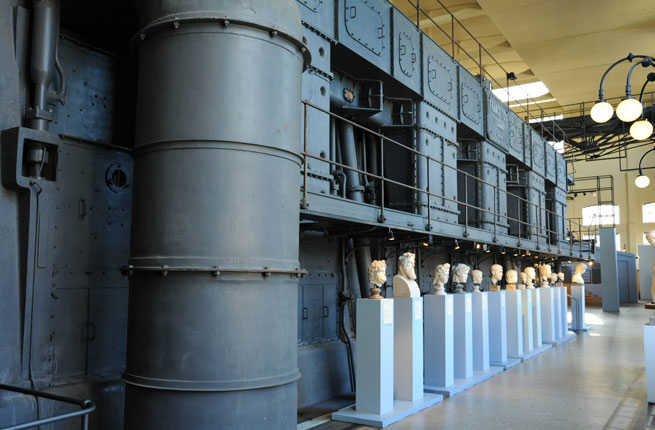
CENTRALE MONTEMARTINI
Aventino
The mix of old and new is particularly apparent at the Centrale Montemartini, an art museum housed in a former power plant. Abandoned in the 1980s, the plant was first used as a temporary exhibition space while the Campidoglio was undergoing renovation. It received such acclaim that it was integrated into Rome’s municipal museum system. The ancient sculptures and mosaics are displayed against a backdrop of industrial machinery, and are part of the Capitoline Museums‘ collection. Unlike the main museum, the Centrale Montemartini rarely has crowds of tourists or lines to get in.
Insider Tip: For a nice stroll, walk up Via Ostiense to see the Piramide di Caio Cestio and the Non-Catholic Cemetery, where Keats and Shelley are buried.
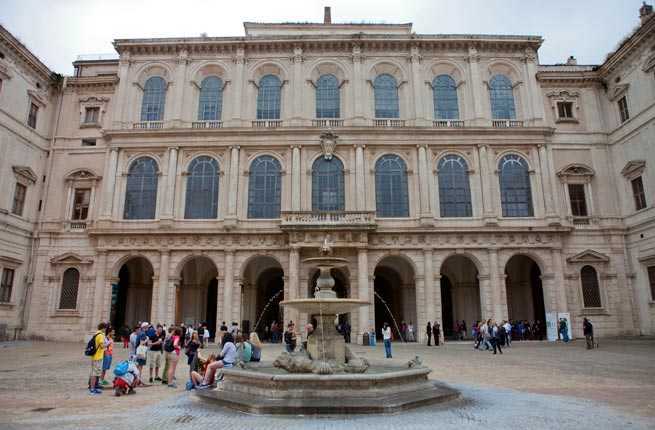
PALAZZO BARBERINI
Quirinale
Stroll down Via Barberini and you’ll immediately be struck by the beauty of the Palazzo Barberini, built in the 1600s as a mansion for the powerful Barberini family. The Palazzo Barberini is part of the family of museums that includes the more famous Galleria Borghese, as well as the Museo Nazionale del Palazzo di Venezia, the Castel Sant’Angelo, and several others. They’re all excellent, but only the Palazzo Barberini contains Raphael’s La Fornarina—modeled on his lover, a baker’s daughter—and Caravaggio’s Judith and Holofernes.
Insider Tip: Don’t forget to look up or you’ll miss baroque painter Pietro da Cortona’s incredible ceiling painting depicting Urban VIII as an agent of Divine Providence, surrounded by giant bees, the symbol of the Barberinis.
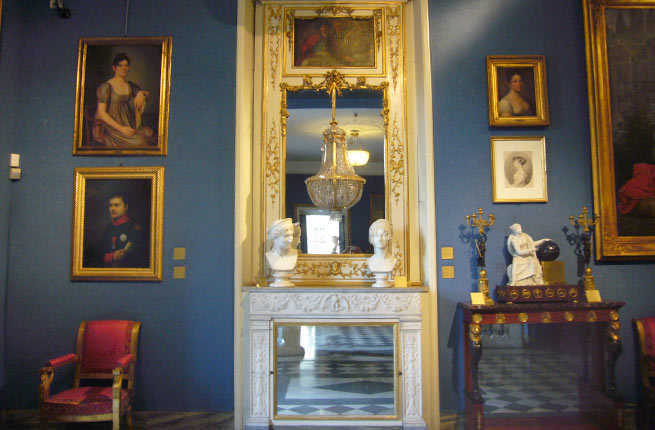
MUSEO NAPOLEONICO
Navona
Walking into the opulent Museo Napoleonico near Piazza Navona, you might feel you’re in Paris rather than Rome. In fact, the entire city could have been more like Paris if Napoleon had succeeded in his conquest of Italy. He seized Rome in 1808, kidnapped the pope, and declared his son the King of Rome. Though his empire fell, visitors today can see Napoleon memorabilia inside his museum, including a bust of his sister by sculptor Antonio Canova. (Canova’s sculpture of Pauline Borghese as Victorious Venus is in the Galleria Borghese.) The Museo Napoleonico is located in the Palazzo Primoli, which also contains the Museo Mario Praz upstairs.
Insider Tip: For coffee or a drink, head over to the nearby Caffè della Pace, included in our list of Rome’s best bars for a classic Italian aperitivo.
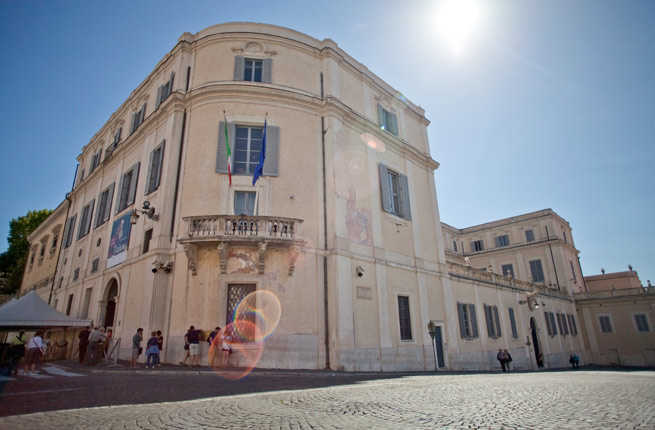
SCUDERIE DEL QUIRINALE
Quirinale
It’s hard to believe that this glorious exhibition space opposite the Palazzo del Quirinale, which houses the President of the Republic, once housed horses. Built on the highest of Rome’s seven hills, the Palazzo del Quirinale dates back to 1583 as a papal summer residence, and the stables were added between 1722-1732. Needless to say, the views from the Quirinale are fantastic, and a recent renovation of the Scuderie restored the great window by Gae Aulenti. The space hosts important temporary exhibitions, including an incredible Caravaggio retrospective in 2010. A major exhibition of Frida Khalo’s work is currently on view.
Insider Tip: A few blocks away stands one of Rome’s most important works of baroque sculpture—Bernini’s awe-inspiring Ecstasy of Saint Theresa inside the Church of Santa Maria della Vittoria.
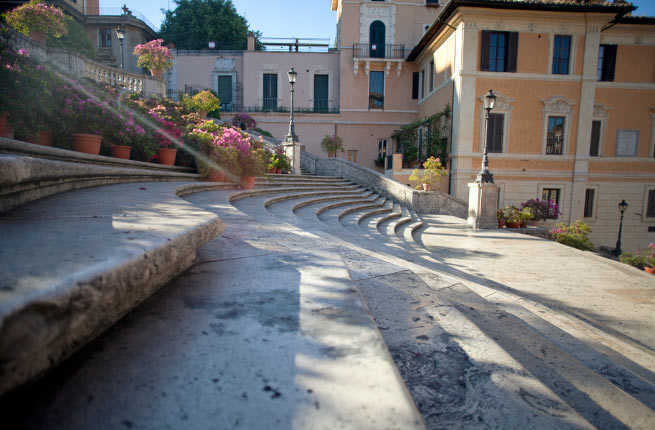
KEATS-SHELLEY MEMORIAL HOUSE
Spagna
Nestled at the foot of the Spanish Steps, the Keats-Shelley Memorial House preserves the apartment where John Keats took his last breath. The museum is dedicated to his memory and that of the English Romantic poets, especially Shelley and Byron. Keats died at age 25 of tuberculosis, and the authorities burned his furniture as a sanitary precaution. The museum, however, displays his original fireplace and ceiling decorated with floral motifs, as well as his letters and many artifacts from the period. It’s a peaceful spot amid the bustle of the Spanish Steps, just as Keats would have wanted it.
Insider Tip: For a coffee or an aperitivo, head to the nearby Enoteca Antica di Via della Croce or the famous Antico Caffe Greco, which Keats and Byron frequented.
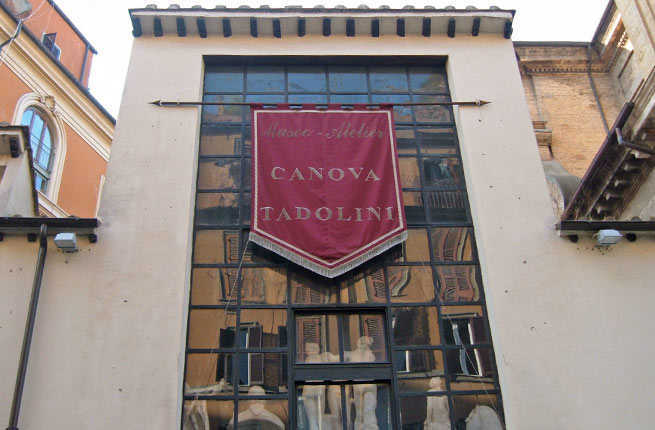
MUSEO-ATELIER CANOVA TADOLINI
Spagna
The Museo-Atelier Canova Tadolini was once the studio of Antonio Canova, one of Europe’s greatest neoclassical sculptors, and his disciple Adamo Tadolini. The main floor has the largest and most impressive sculptures, as well as the café. Upstairs, there are some more intimate and formal dining rooms, perfect for a romantic dinner. Scattered throughout, you can see the sculptors’ tools. A proper meal here isn’t cheap, but it’s worth it to dine surrounded by the profusion of majestic marble sculptures and plaster casts.
Insider Tip: Canova’s sculptures are scattered all over the world, but you can see his Principessa Pauline Borghese (Napoleon’s sister) as Victorious Venus at the Galleria Borghese and Perseus with the Head of Medusa at the Vatican Museums.
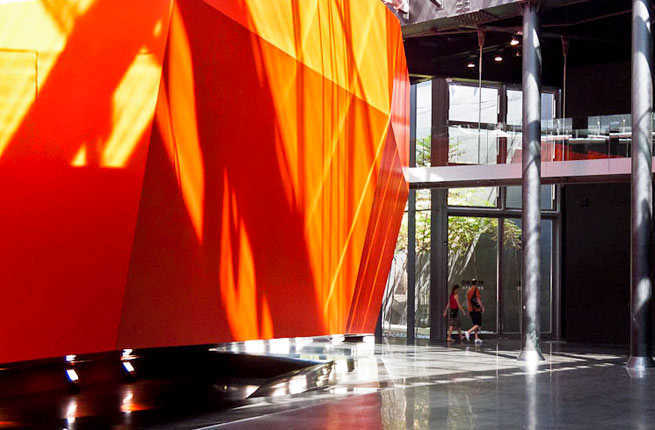
MACRO
Repubblica
MACRO—Museo d’arte contemporanea Roma—is one of two major museums dedicated to contemporary art. Here, in the former Peroni beer brewery, living Italian artists get their due. French archictect Odile Decq designed the museum, with its giant red cuboid in the center and its large rooftop terrace that acts as both gathering space and exhibition space. MACRO’s sister site, MACRO Testaccio, is housed in a former slaughterhouse in a neighborhood now known for its bohemian atmosphere and many nightclubs.
Insider Tip: MACRO is a bit far from the subway, but is easily reachable by tram or bus.
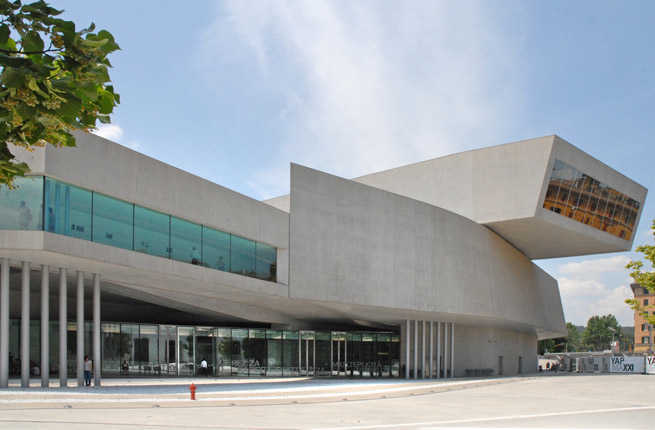
Attribution-NonCommercial-ShareAlike License
MAXXI
Piazza del Popolo
Rome’s other major contemporary art museum is the MAXXI—Museo Nazionale delle arti del XXI secolo (National Museum of 21st century arts). Designed by Zaha Hadid, its name suggests the maximum, and visitors will feel that its monumental architecture fulfills that expectation. Hadid’s monochromatic building blurs the lines between interior and exterior with an abundance of natural light, large open spaces, and long, curving staircases. Since its opening in 2010, the museum has shown work by some of the world’s most important contemporary artists and architects, including Anish Kapoor, Joseph Beuys, Jan Fabre, Le Corbusier, and Carlo Scarpa.
Insider Tip: MAXXI is located near the Olympic Stadium, just outside the historic center, and is easily accessible by tram from Piazza del Popolo. Nearby, the Ponte Milvio area has lots of bars and restaurants favored by locals.
Visit to Rome
7 Unique Tours of Rome
Just because all roads lead to Rome doesn’t mean they converge into a single route once they get there. When in Rome, forgo the well-trodden tourist path altogether in favor of some offbeat adventuring, courtesy of these seven unique tours, each guaranteed to show you a different side of this ancient city. Plus, all of these distinctive options offers a welcome reprieve from walking by putting your sightseeing on wheels. So go ahead and see Rome in one-of-a-kind style—your (modern-day) chariot awaits.
Slide Behind the Wheel of a Vintage Fiat 500

Italian auto designers gave the world top-notch supercars with Ferrari, Lamborghini, and Alfa Romeo, but the feel-good Fiat 500 does its part to capture the hearts and imaginations of the masses. Get behind the wheel of this happy little car—or be chauffeured, if you prefer—courtesy of ROME 500 EXP, which operates a fleet of six of the vintage vehicles within Rome proper. Choose your favorite classic ’60s or ’70s model, pop open the sunroof, and head out on a guided convoy-style tour featuring piped-in commentary from the tour leader as you circuit Rome, incorporating short stops at key sights. Several tour variations are possible, but we like the four-hour option that wraps up with a wine-and-food pairing at a sophisticated wine bar, set just steps from the Colosseum. $200/person, two-passenger minimum; for self-drive tours, note vehicles are manual and an international license is required
Pedal Past History on the Ancient Appian Way

Travel paths once paved for chariots as you weave past ancient Roman statues, tombs, and aqueducts, and alongside the ruins of a circus and imperial palace. Some 2,300 years since this commercial route was first built, the transporting Appian Way still beckons travelers. The pros at TopBike lead guided, six-hour, 18.5-mile-long bike tours here that are suitable for intermediate riders, following mostly flat terrain (though some is off-road), and offering plenty of breaks for commentary and rest. Tours also include a guided visit of the fascinating Christian burial site, the Catacombs of San Callisto, as well as a stop for cheese and wine at a local sheep farm. $108/person
Cruise the City by Night on a Vintage Vespa
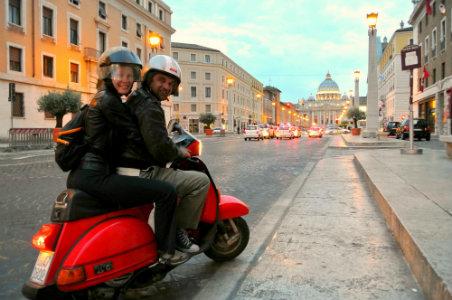
See Rome in a new light, by night, with ageless monuments set softly aglow as you navigate the chaotic whirl of Roman traffic, traversing narrow alleyways and sweeping squares on the back of a vintage Vespa. Nerone Tours Italy offers the ultimate cinematic tour of the Eternal City— à la Audrey Hepburn and Gregory Peck in Roman Holiday—via Vespa (or Lambretta) scooters. Drivers stand in as informal guides, though you’ll only half-catch their commentary as the wind sweeps through your hair and as each twist and turn reveals a dramatically lit facade vying for your attention. Three-hour nighttime tours kick off from your hotel around dusk (at 8 p.m.), and can be customized based on guests’ interests, or left up to the drivers for some broad-stroke highlights; if the thrill of the ride isn’t enough to keep your adrenaline up, a coffee stop is also included. $218/person
Set Out on Segway to the Hidden Hill of Trastevere

Segways are just plain fun, and this modern mode of transport makes for an interesting juxtaposition while exploring Roman antiquity. Make the run with Rex Tours, who rank top for their pleasant, insightful guides; thorough coaching on operating the Segways; and diverse tour options. We especially like their 3.5-hour, small group Trastevere tour, which rolls through this charming historic hilltop neighborhood, where lost-in-time alleyways, flanked by medieval architecture, lead to impressive, less-trodden points of interest and panoramic vistas over Rome. $108/person
Whiz About Town in an Electric Car

The nifty electric, two-seater cars of Buzz4Tours, packaged as “personal commuters,” are compact enough to skirt traffic and to park just about anywhere (bonus: parking for electric cars in Rome is free). Sign up for caravan-style, four-hour tours for a discovery of Rome’s must-sees—you’ll follow a lead car, helmed by a professional guide, who offers up commentary via walkie-talkie transmission. Or, you can opt in for an independent half- or full-day circuit, swapping out the tour guide for an iPad that comes preloaded with GPS-led itineraries, Internet access, and Skype. $89/person for guided tours; an international license is required
Get Your Groove on in a Historic Tram

Pair ancient sites with classic tunes on this one-of-a-kind tour of Roma. Dreamt up by an American expat musician and his Roman girlfriend, these lively evening tours transform one of Rome’s few remaining historic street trams into a mobile, music-themed party fueled by free-flowing Italian wine and aperitivo-style small plates. A live band turns out a mix of classic rock (à la the Beatles and Elvis), Italian favorites (like Antonello Venditti and Lucio Battisti), and Italian-American legends (Sinatra, Dean Martin), while the backdrop of Roman monuments flashes by (commentary is provided), including a pit stop at the Colosseum for an atmospheric alfresco dance party. Tram Tracks run most Monday nights, and last 90 minutes. $55/person
Zoom on a Golf Cart for Family Fun
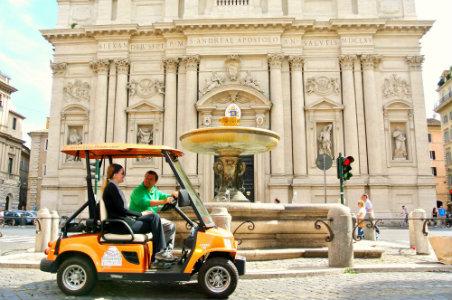
Hop aboard an electric golf cart for some guaranteed family fun. Especially well-suited for kids, seniors, and the mobility impaired, these easy-breezy tours were designed by the Irish expat owner of Angel Tours, who was seeking a comfortable way of showing his elderly out-of-town mom the sights. It was a hit with mom, and customers soon agreed. Plus, the carts are eco-friendly and can be driven and parked almost anywhere, for four hours of chauffeured hop-on, hop-off access to the major sites, including the Pantheon, St. Peter’s Square, and more, along with a break for ice cream or coffee. $109/adults; reduced rates for kids (under 6 are free); an international driving permit is required for driving
Elissa Richard is a contributor to numerous American travel publications, including Fodor’s, Condé Nast Traveler, Travel + Leisure, Yahoo, and more. Based in Brooklyn, NY, she has traveled to and reported on some 55 countries and 20 cruise lines around the globe, and has resided in Argentina, France, England, Denmark, and the Netherlands. Follow her @TravelSpiritNYC.
-
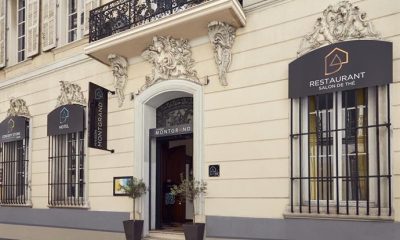
 France6 years ago
France6 years agoHotel Maison Montgrand – Vieux Port
-

 United Kingdom6 years ago
United Kingdom6 years agoBritannia International Hotel Canary Wharf
-
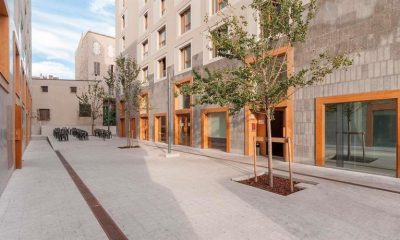
 France6 years ago
France6 years agoAppart’City Marseille Euromed
-
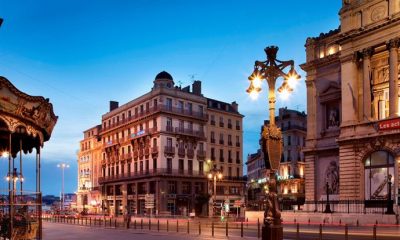
 France6 years ago
France6 years agoEscale Oceania Marseille Vieux Port
-
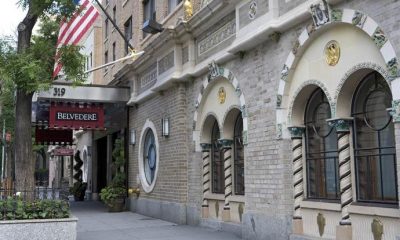
 USA6 years ago
USA6 years agoThe Belvedere
-

 United Kingdom6 years ago
United Kingdom6 years agoBest Western London Peckham Hotel
-
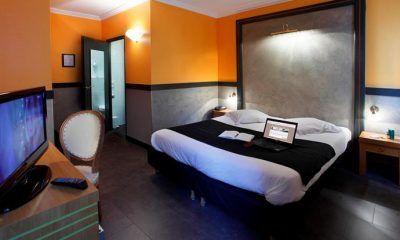
 France6 years ago
France6 years agoAdonis Marseille Vieux Port
-
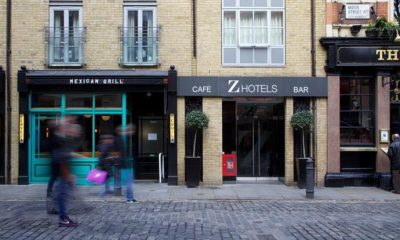
 United Kingdom6 years ago
United Kingdom6 years agoThe Z Hotel Soho






